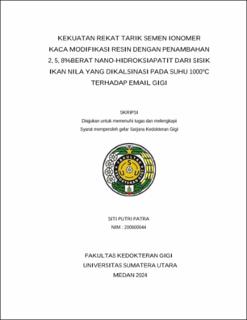| dc.contributor.advisor | Harahap, Kholidina Imanda | |
| dc.contributor.author | Patra, Siti Putri | |
| dc.date.accessioned | 2024-07-04T04:38:55Z | |
| dc.date.available | 2024-07-04T04:38:55Z | |
| dc.date.issued | 2024 | |
| dc.identifier.uri | https://repositori.usu.ac.id/handle/123456789/94320 | |
| dc.description.abstract | Resin modified glass ionomer cement (RMGIC) has low tensile bond strength.
This needs to be paid attention to because it will receive various kinds of forces in the
oral cavity. The tensile bond strength of RMGIC can be increased by the addition of
nano-hydroxyapatite. Nano-hydroxyapatite can be synthesized from natural materials
such as tilapia fish scales. The aim of this research was to analyze differences in the
tensile bond strength of RMGIC after the addition of 2, 5, and 8% by weight of nanohydroxyapatite
of tilapia fish scales calcined at 1000°C to tooth enamel. Nanohydroxyapatite
was obtained from tilapia fish scales through a calcination process at
1000°C for 2 hours and the size was reduced using a ball-mill at 350 rpm for 1 hour.
Then the hydroxyapatite particles were measured using a particle size analyzer. The
research sample was in the form of a tablet with a diameter of 4 mm and a height of 2
mm. A total of 40 samples were divided into four groups, namely without addition and
addition of 2, 5, and 8% by weight of nano-hydroxyapatite. The sample was bonded to
the palatal surface of premolar tooth enamel after being embedded in self-polymerizing
acrylic resin. The enamel surface is removed by 0.005mm, smeared with dentinconditioner
for 20 seconds, and placed on the master-cast. The ratio of RMGIC
powder:nano-hydroxyapatite:liquid in groups 2, 3 and 4 is 0.123:0.002:0.05g; 0.119:0.006:0.05g; and 0.115:0.010:0.05g. After being stirred homogeneously, the
material is put into a mold with a diameter of 4 mm and a height of 2 mm which is
placed on the tooth surface. The mold was covered with a celluloid strip and then
illuminated with LED light cure for 40 seconds. The samples were soaked in distilled
water for 24 hours before being tested for tensile bond strength using a universal
testing machine. The average results of tensile bond strength in groups 1, 2, 3, and 4
were 6.34 ± 0.52 MPa, 7.34 ± 0.21 MPa 7.82 ± 0.21 MPa; and 9.01 ± 0.31 MPa. The
results of the Kruskal Wallis test showed that there was a significant difference in
tensile bond strength between groups (p<0.05). It can be concluded that there is a
difference in the tensile bond strength of RMGIC after the addition of 2, 5, and 8% by
weight of nano-hydroxyapatite of tilapia fish scales to tooth enamel. The tensile bond
strength value of RMGIC was highest with the addition of 8% by weight of nanohydroxyapatite. | en_US |
| dc.language.iso | id | en_US |
| dc.publisher | Universitas Sumatera Utara | en_US |
| dc.subject | tensile bond strength | en_US |
| dc.subject | nano-hydroxyapatite | en_US |
| dc.subject | tilapia fish scale | en_US |
| dc.subject | RMGIC | en_US |
| dc.subject | SDGs | en_US |
| dc.title | Kekuatan Rekat Tarik Semen Ionomer Kaca Modifikasi Resin dengan Penambahan 2, 5, 8%Berat Nano-Hidroksiapatit dari Sisik Ikan Nila yang Dikalsinasi pada Suhu 1000oc terhadap Email Gigi | en_US |
| dc.title.alternative | Tensile Bond Strength of Resin Modified Glass Ionomer Cement with the Addition of 2, 5, 8%Weight of Nano-Hydroxyapatite from Tilapia Fish Scales Calcined at 1000˚C to Tooth Enamel | en_US |
| dc.type | Thesis | en_US |
| dc.identifier.nim | NIM200600044 | |
| dc.identifier.nidn | NIDN0011098205 | |
| dc.identifier.kodeprodi | KODEPRODI12201#Pendidikan Dokter Gigi | |
| dc.description.pages | 106 Pages | en_US |
| dc.description.type | Skripsi Sarjana | en_US |


